 |
|
|
|

In the orientation phase, students select a topic of study that interests them and familiarize themselves with the instruments they'll need to collect their data.
On this Voyage of Discovery, the students organized into three teams of four students each, each focusing on a specific field of study. In turn, each research team would work closely with a pair of senior crew advisors.
Starting on Day Two and working into Day Three, the students began their voyage by learning about each possible topic and familiarizing themselves with our intruments by maintaining the Deck Log. They also used this time to devise a hypothesis or guided question that they would then test for their presentation projects. Although the research teams' individual projects would be tightly focused, each student would also learn how to perform every experiment, including several which are not currently part of anyone's research projects.
|
Presentation Project Topics |
|
|
|
|
Since learning to use our scientific gear is a central part of the orientation phase, the photos below may illustrate our student crew members taking readings for the Deck Log rather than focusing on the topics of their own projects.
Scroll down or use the menu to jump directly to a specific project.
|
Research Team 1: Celestial Tracking
|
| 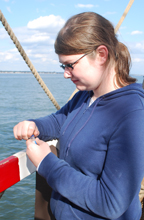 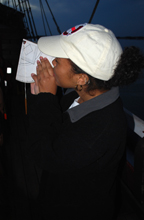 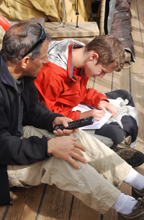 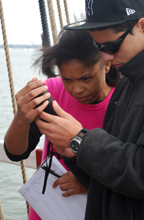
Students: Amanda, Bibi, Karl & Monet
Senior Crew Advisors: Miles Garfinkel & Jennifer Reilly
Guiding Question: Does the sun really rise in the east and set in the west?
The Celestial Tracking team will use a quadrant and directional compass to track the course of the sun across the sky. While the primary goal of their guiding question will involve reading the bearing (or azimuth) of the sun at sunrise and sunset, they will continue to track its altitude bearing throughout the day to determine the time of local noon.
Back to Top
|
Research Team 2: Mechanical Advantage
|
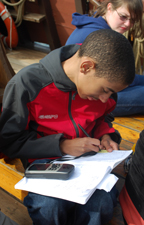 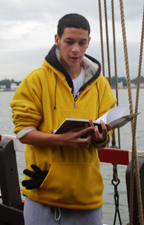 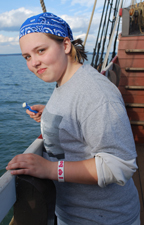 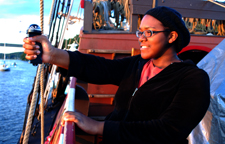
Students: Erica, Kelsey, Roberto & Solange
Senior Crew Advisors: Anthony Roy & Woody Woodworth
Hypothesis: The force needed to lift an object will decrease as more pulleys are added to the machine, and this difference in force will depend on the length of line pulled through the rig.
The Mechanical Advantage team will construct a block-and-tackle simple machine in several configurations, measuring the force needed to lift a fixed weight a fixed distance, as well as the length of line that must be pulled through the machine to obtain those results.
|
Research Team 3: Statistical Analysis
|
Students: Claudio, Daniel, Teara & Wilberto
Senior Crew Advisors: Stephanie Bisson & Ralf Hensel
Guiding Question: What are the bearings of three fixed objects, as measured with two types of compass, and will there be a difference between trained and untrained results?
The Statistical Analysis team will organize the crew at three separate locations, having everyone read the compass bearing of a fixed landmark nearby. They will then analyze the crews' combined results to test if using different styles of compass affects their results, as well as testing whether instructing their crewmates on how to use the equipment beforehand will improve their results.
|
|
|
|

